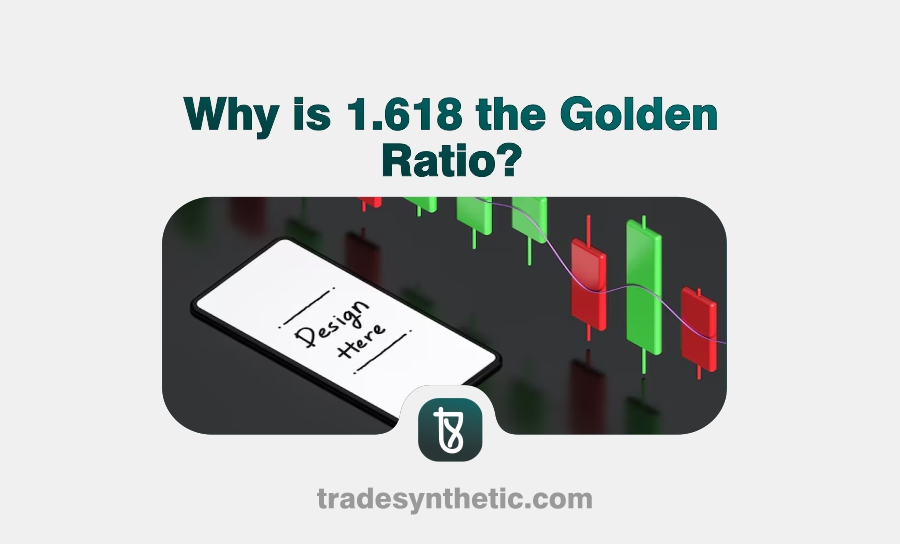You might wonder, “Why is 1.618 the Golden Ratio” considered special. The number 1.618, known as the golden ratio, stands out as one of the most mysterious and fascinating mathematical constants. This ratio appears everywhere—from nature and art to architecture and financial markets.
This article explores the origin and meaning of the golden ratio, explains how to calculate it, reveals where to find it, uncovers its connection to the Fibonacci sequence, and highlights its presence in nature, design, and trading. You’ll also learn why people call it the “divine proportion.”
What is 1.618 the Golden Ratio?
The golden ratio, also called phi (Φ), is an irrational number approximately equal to 1.6180339887. It is derived from a simple mathematical relationship:
Φ=a+b/a=b/a
This equation states that when you divide a line segment into two parts (a and b), the ratio of the whole segment (a + b) to the longer part (a) is equal to the ratio of the longer part (a) to the shorter part (b).
You can find this ratio everywhere—from the spirals of galaxies to the human body, and even in stock market charts.
The Golden Ratio and the Fibonacci Sequence
One of the most interesting things about 1.618 is its connection to the Fibonacci sequence.
The Fibonacci sequence is a series of numbers where each number is the sum of the two preceding ones:
0,1,1,2,3,5,8,13,21,34,55,89, 144,0, 1, 1, 2, 3, 5, 8, 13, 21, 34, 55, 89, 144, …0,1,1,2,3,5,8,13,21,34,55,89,144, …
As you go further in this sequence, the ratio of consecutive Fibonacci numbers approaches 1.618.
For example:
- 5 ÷ 3 = 1.666
- 8 ÷ 5 = 1.6
- 13 ÷ 8 = 1.625
- 21 ÷ 13 = 1.615
The larger the Fibonacci numbers, the closer their ratio gets to 1.618.
Where Can You Find the Golden Ratio?
The golden ratio is not just a mathematical theory, it appears in real-world structures, biological growth, and even human-made designs. Here are some key places where you can find it:
Nature
- The spirals of sunflowers, pinecones, and seashells follow the golden ratio.
- The branching of trees and the arrangement of leaves (phyllotaxis) follow Fibonacci patterns.
- The proportions of the human body, such as the ratio of your forearm to your hand, follow the golden ratio.
Art and Architecture
- The Parthenon in Greece was designed using golden ratio proportions.
- Renaissance artists like Leonardo da Vinci used it in paintings like The Last Supper and Vitruvian Man.
- The Notre-Dame Cathedral and Pyramids of Egypt are built with golden proportions.
Finance and Trading
- Traders use Fibonacci retracement levels (23.6%, 38.2%, 50%, 61.8%, 78.6%) in technical analysis to predict price reversals.
- Stock charts often show price movements that align with golden ratio levels.
- Traders use Fibonacci tools to identify entry and exit points in the market.
The Golden Ratio in Technology and Design
- Apple’s logo and many modern designs follow golden ratio proportions.
- The aspect ratio of many famous paintings and photographs is close to 1.618.
- Website layouts and UI designs use golden rectangles for better aesthetics.
The presence of 1.618 in so many fields shows its universal appeal and significance.
Why is 1.618 the “Divine Proportion”?
The golden ratio has been called the “divine proportion” because of its natural harmony and balance. Here’s why:
1. It Represents Perfect Symmetry and Beauty
- Faces, bodies, and objects that follow the golden ratio are often seen as more attractive.
- Famous artworks, logos, and buildings use this ratio to create aesthetic appeal.
2. It Shows Up in Growth Patterns
- DNA molecules, hurricanes, and even galaxies follow golden spirals.
- It appears in natural growth sequences like seed patterns in flowers.
3. It Has a Unique Mathematical Property
- The golden ratio is self-replicating—meaning Φ² = Φ + 1.
- This makes it a fundamental part of proportions, geometry, and symmetry.
For centuries, scientists, artists, and mathematicians have admired 1.618 for its perfect balance and harmony.
Myths and Misconceptions About the Golden Ratio
Despite its beauty and significance, there are some misconceptions about the golden ratio:
- Not everything in nature follows 1.618 exactly—some patterns are close but not precise.
- The golden ratio does not guarantee beauty—it’s a useful guideline, not a rule.
- It’s not a magical formula—while it appears in art and science, it doesn’t control the universe.
Conclusion
In summary, the number 1.618, or the golden ratio, is a timeless mathematical concept that appears in nature, art, architecture, trading, and even human design. The Fibonacci sequence connects to it, and you can find it in spirals, galaxies, and stock markets. Artists, architects, and designers use it for harmony and balance. Most importantly, traders apply it to market analysis for price movements and trends.
Frequently Asked Questions (FAQs)
Why is 1.618 called the golden ratio?
- It is called the golden ratio because it appears naturally in proportions, growth patterns, and art, creating harmony and balance.
What is the relationship between the golden ratio and the Fibonacci sequence?
- The ratio of consecutive Fibonacci numbers approaches 1.618 as the sequence progresses.
Does the golden ratio exist in the stock market?
- Yes, traders use Fibonacci retracement levels (23.6%, 38.2%, 50%, 61.8%, 78.6%) to predict price movements.
Why do traders rely on Fibonacci retracement levels?
- Traders use Fibonacci retracements because price movements often follow these levels. They act as support and resistance zones, helping traders predict potential reversals and make informed decisions.
Is the golden ratio always 1.618?
- While 1.618 is the most common value, variations of the golden ratio exist. For instance, the inverse (0.618) also plays a crucial role in geometry, design, and financial analysis.










